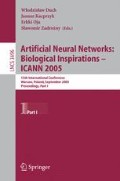Abstract
Introducing partial connectivity to an associative memory network increases the variance of the dendritic sum distributions, reducing the performance. A coding scheme to compensate for this effect is considered, in which output patterns are self-organised by the network. It is shown using signal-to-noise ratio analysis that when the output patterns are self-organised the performance is greater than in a network with a higher connectivity and random patterns, in the regime of low connectivity and a high memory load. This analysis is supported by simulations. The self-organising network also outperforms the random network with input activity-dependent thresholding mechanisms in simulations.
Access this chapter
Tax calculation will be finalised at checkout
Purchases are for personal use only
Preview
Unable to display preview. Download preview PDF.
References
Willshaw, D.J., Buneman, O.P., Longuet-Higgins, H.C.: Non-holographic associative memory. Nature 222(197), 960–962 (1969)
Buckingham, J.: Delicate nets, faint recollections: a study of partially connected associative network memories. PhD thesis, Univ. Edinburgh (1991)
Marr, D.: Simple memory: a theory for archicortex. Phil. Trans. R. Soc. B. 262(841), 24–81 (1971)
Buckingham, J., Willshaw, D.J.: On setting unit thresholds in an incompletely connected associative net. Network 4, 441–459 (1993)
Graham, B., Willshaw, D.J.: Improving recall from an associative memory. Biol. Cybernetics 72, 337–346 (1995)
Freund, T.F., Buzsaki, G.: Interneurons of the Hippocampus. Hippocampus 6, 347–470 (1996)
Dayan, P., Willshaw, D.J.: Optimizing synaptic learning rules in linear associative memories. Biol. Cybernet. 65(4), 253–265 (1991)
Treves, A.: Quantitative estimate of the information relayed by the Schaffer collaterals. J. Comp. Neuro. 2(3), 259–272 (1995)
Brun, V.H., Otnass, M.K., Molden, S., Steffenach, H.A., Witter, M.P., Moser, M.B., Moser, E.I.: Place cells and place recognition maintained by direct entorhinal-hippocampal circuitry. Science 296(5576), 2243–2246 (2002)
Author information
Authors and Affiliations
Editor information
Editors and Affiliations
Rights and permissions
Copyright information
© 2005 Springer-Verlag Berlin Heidelberg
About this paper
Cite this paper
Longden, K. (2005). Recovery of Performance in a Partially Connected Associative Memory Network Through Coding. In: Duch, W., Kacprzyk, J., Oja, E., Zadrożny, S. (eds) Artificial Neural Networks: Biological Inspirations – ICANN 2005. ICANN 2005. Lecture Notes in Computer Science, vol 3696. Springer, Berlin, Heidelberg. https://doi.org/10.1007/11550822_31
Download citation
DOI: https://doi.org/10.1007/11550822_31
Publisher Name: Springer, Berlin, Heidelberg
Print ISBN: 978-3-540-28752-0
Online ISBN: 978-3-540-28754-4
eBook Packages: Computer ScienceComputer Science (R0)

